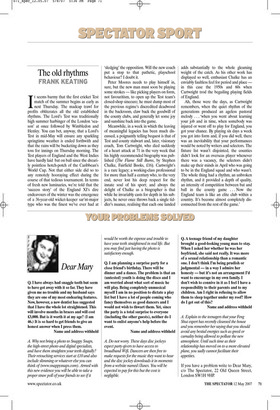The old rhythms
FRANK KEATING
It seems barmy that the first cricket Test match of the summer begins as early as next Thursday. The madcap trawl for profits obliterates all the old established rhythms. The Lord’s Test was traditionally high summer harbinger of the London ‘season’ at once followed by Wimbledon and Henley. You can bet, anyway, that a Lord’s Test in mid-May will ensure any sparkling springtime weather is ended forthwith and that the rains will be bucketing down as they toss for innings on Thursday morning. The Test players of England and the West Indies have hardly laid bat on ball since the drearily pointless hotch-potch of the Caribbean’s World Cup. Not that either side did so to any remotely hooraying effect during the course of that tedious tournament. In terms of fresh new luminaries, we’re told that the ‘success story’ of the England XI’s dire endeavours of the winter was the emergence of a 36-year-old wicket-keeper sar’nt-major type who was the finest we’ve ever had at ‘sledging’ the opposition. Will the new coach put a stop to that pathetic, playschool behaviour? I doubt it.
Peter Moores needs to play himself in, sure, but the new man must soon be playing some strokes — like picking players on form, not favouritism, to open up the Test team’s closed-shop sinecure; he must dump most of the previous regime’s discredited deadwood in the backroom, claw back the goodwill of the county clubs, and generally let some joy and sunshine back into the game.
Meanwhile, in a week in which the leaving of meaningful legacies has been much discussed, a poignantly telling bequest is that of Test and county stalwart and, later, visionary coach, Tom Cartwright, who died suddenly of a heart attack at 71 in the very week that his highly recommended biography was published (The Flame Still Burns, by Stephen Chalke, Fairfield Books, £16). Cartwright’s is a rare legacy; a working-class professional for more than half a century who, to the very end, never lost his deep respect for the innate soul of his sport; and always the delight of Chalke as a biographer is that while he invariably casts for depth in his subjects, he never once throws back a single tiddler’s nuance, realising that each one landed adds substantially to the whole gleaming weight of the catch. As his other work has displayed so well, enthusiast Chalke has an enviably faultless feel for period and place in this case the 1950s and 60s when Cartwright trod the beguiling playing fields of England.
Ah, those were the days, as Cartwright remembers, when the quiet rhythm of the generations produced an ageless pastoral melody ... ‘when you went about learning your job and in time, when somebody was injured or went off to play for England, you got your chance. By playing six days a week you got into form and, if you did well, there was an inevitability that your performances would be noted by writers and selectors. The fixture list wasn’t disjointed, the counties didn’t look for an overseas player whenever there was a vacancy, the selectors didn’t make up their minds in April who was going to be in the England squad and who wasn’t. The whole thing had a rhythm, an unbroken rhythm, and it provided a depth of quality, an intensity of competition between bat and ball in the county game ... Now the England team is like an elite club within a country. It’s become almost completely disconnected from the rest of the game.’










































































 Previous page
Previous page